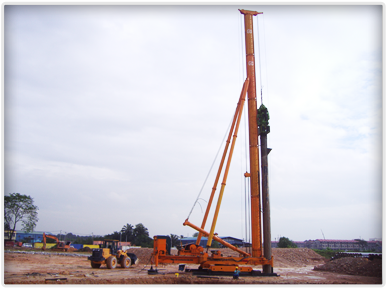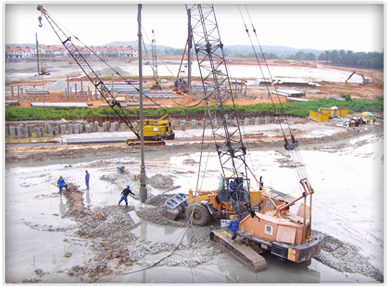
Vibro Stone Column
Stone column is possibly the most “natural” ground treatment or foundation system in existence. Consisting entirely of gravel, a substance that is found naturally in the subsoil, no additives are mixed into the stone columns. More environmentally neutral, they are also more durable than other foundation system involving the use of cement or steel.
Stone column is a technique of ground improvement used to enhance the load bearing capacity of the soil. A stone column consists of crushed coarse aggregates of various sizes. The ratio of sizes of stones to be mixed is decided through criteria of design. The aforementioned crushed aggregates in the definite proportions are to be placed into the soil at regular intervals all over the area where the soil bearing capacity is to be improved. This can be done in 2 methods of vibratory probe penetration until the designated depth by either dry or wet process.
The vibrations of the probe will cause the grain structure of the surrounding subsoil to collapse and ultimately the soil surrounding the probe will become denser. A backfill of crushed aggregates or gravels is used to replace the displaced soil; forming stone columns in the process as well as providing a degree of reinforcement. This procedure also provides a potentially effective means of drainage for excess pore water to be dissipated through the stone column in order to achieve a rapid consolidation.
Stone columns are installed across the required ground treatment area in a patterned grid at regular intervals. The diagram below shows the typical earth/ground cross section treated with stone column.


Stone column is a technique of ground improvement used to enhance the load bearing capacity of the soil. A stone column consists of crushed coarse aggregates of various sizes. The ratio of sizes of stones to be mixed is decided through criteria of design. The aforementioned crushed aggregates in the definite proportions are to be placed into the soil at regular intervals all over the area where the soil bearing capacity is to be improved. This can be done in 2 methods of vibratory probe penetration until the designated depth by either dry or wet process.
The vibrations of the probe will cause the grain structure of the surrounding subsoil to collapse and ultimately the soil surrounding the probe will become denser. A backfill of crushed aggregates or gravels is used to replace the displaced soil; forming stone columns in the process as well as providing a degree of reinforcement. This procedure also provides a potentially effective means of drainage for excess pore water to be dissipated through the stone column in order to achieve a rapid consolidation.
Stone columns are installed across the required ground treatment area in a patterned grid at regular intervals. The diagram below shows the typical earth/ground cross section treated with stone column.
- DRY METHOD
- WET METHOD

A schematic of the vibro replacement process
| 1. | A special casing attached to the vibrator will penetrate to the required depth due to the vibrations. |
| 2. | Gravel is added through a hopper and supply tube to the tip of the vibrator. The upward and downward movements of the vibrator will compact the gravel with the pull-down being employed during the downward compacting action. |
| 3. | With the addition of gravel necessary in the construction procedure, a stone column of high integrity and tightly interlocked with the surrounding soil is thus built up to ground level. |

A schematic showing the vibro replacement process
| 1. | Assisted by water jetting, the vibrator penetrates to the design depth under its own weight. The jets then maintain a space around the vibrator. |
| 2. | Crushed stone backfill is introduced in discrete lifts. The horizontal forces of the vibrator laterally compact the stone against the surrounding soil. |
| 3. | The process is repeated up to ground level, forming a well compacted, tightly interlocked stone column surrounded by soil of enhanced density. |



